Sacred Forests:
The Story of the Logs for the Hulls of Hawai‘iloa
Sam Low
1. The Search
In 1990, the Polynesian Voyaging Society decided to create a new canoe, to be called Hawai'iloa after a famous Tahitian navigator. Hawai'iloa would be built of traditional materials - lauhala for the sails, olana for the lashings, koa for the hulls, ohia for crossbeams to connect the hulls, and hau for stanchions, decks and steering paddles.
"Hokule'a was built quickly, of modern materials mostly," Nainoa Thompson recalls, "and then we went right into sailing - it was an ocean project - the emphasis was on sailing her, not building her. But when our ancestors built and sailed voyaging canoes, it required the labor and arts of the entire community, everyone working together - some collecting the materials in the forest, others weaving the sails, carving the hulls, lashing, preparing food for the voyage, practicing rituals to protect the crew at sea. So we thought that building a canoe of traditional materials would bring our entire community together, not just the sailors, but the craftspeople, artists, chanters, dancers and carvers. The Native Hawaiian Culture and Arts Program was set up to build not just a canoe - but a sense of community - by recreating Hawaiian culture."
Nainoa hoped they could find traditional materials to build the canoe in Hawaii. He was particularly concerned about finding two large koa logs for the hulls. For nine months, almost every weekend, teams of koa hunters fanned out through Hawaii's forests. They walked over hundreds of square miles on Molokai, Maui, Kauai and Hawaii. They followed tips from foresters, naturalists, game wardens and hunters. Once they discovered an extremely large and promising tree but it was rotten. It had probably died fifty earlier.
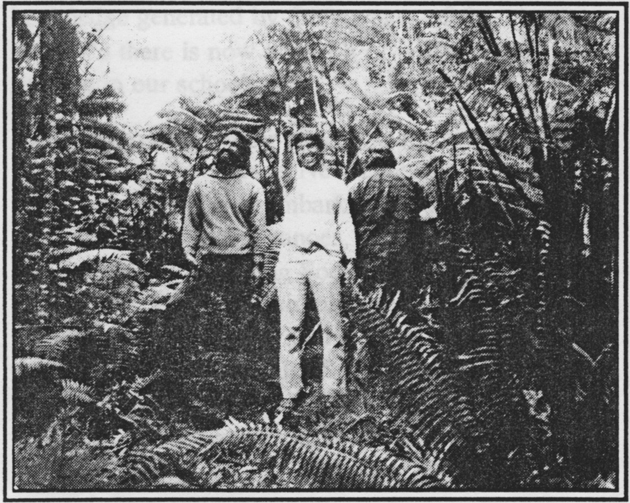
Nainoa with Shorty and Clay Bertelmann of Moku o Hawai‘i searching for koa for a canoe, c. 1990
As the days passed without success, Nainoa worried. If they did not find the trees the dream of building Hawai'iloa of native Hawaiian wood, after years of planning and soaring hopes, would certainly fail. Time was running out.
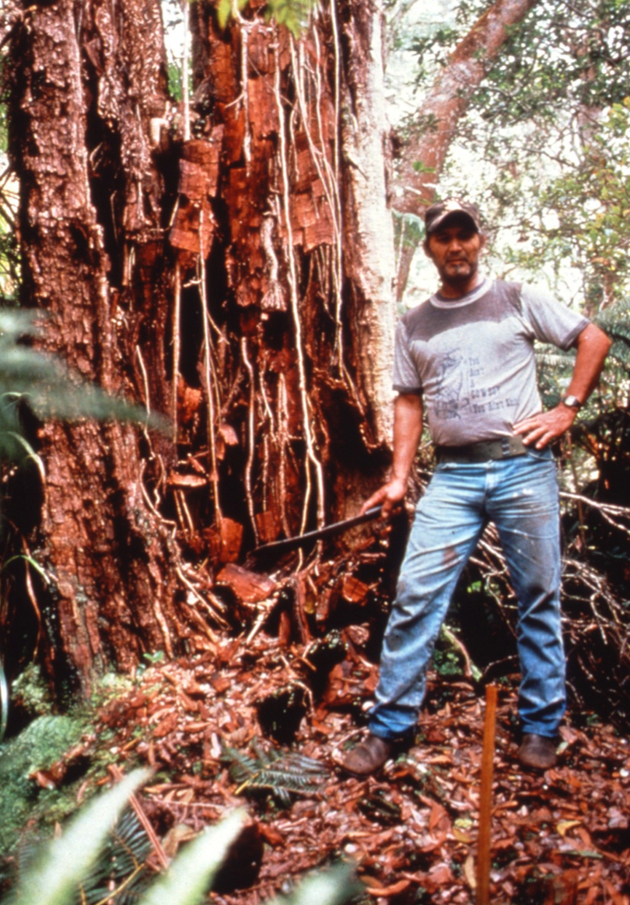
On a weekend in the middle of March, 1991, Nainoa and Tava Taupu searched the remains of a once dense Koa forest on the flanks of Kilauea volcano on the Big Island. They scanned the trees around them, measuring the trunks visually, looking for one large enough to carve into the 60 foot hull of a voyaging canoe.
"We searched that weekend with a large team and found nothing," Nainoa says. "Everyone had to go back to work on Monday but Tava and I stayed up in the forest and we decided that Tuesday, March 18th, was our last chance. At that point I was very sad and depressed by the difference between what I imagined the forest to look like and what it actually looked like."
"All around us were alien species and ferns uprooted by feral pigs. I saw a layer of vines twisted in the canopy from one tree to another, choking the trees. The fence line between the Kilauea forest and Keahou ranch created a stark contrast. How small the reserve seemed when compared to the ranch. How much had been cut down."
"'There's a fence line up ahead about a half mile,' I told Tava, 'I'll go up slope and we'll work towards it together to cover more ground. We'll meet at the fence. If we don't find anything, that will be it.' We knew that it was probably a futile attempt, but it was our last chance."
It was getting cold as the two men neared the fence line. Mist sifted through the trees and collected on Nainoa's fleece jacket. He raised the collar and hunkered into its warmth. Reaching the fence, he joined Tava and they continued together downslope toward the sea. They came to a place where prairie grass lapped at their legs with a swishing sound like the ocean on a sheltered beach. The view opened out to wide expanses of ranch land with cattle in the far distance. They headed toward a four wheel drive truck parked in grass up to its hubcaps.
"I saw Tava and he saw me but we didn't say anything. We each knew that the other had not found a tree. There was nothing to say, because there was nothing good to say. We did not even walk on the same side of the road and Tava walked behind me, as if we were repelled by each other. We were very depressed. We did not achieve what we so much wanted to achieve. But beyond that, I think the erosion of the forest was eroding something inside of us. We didn't want to mess with each other. I walked ahead. He walked behind."
A single alternative remained. Nainoa did not want to accept it but he knew that it was the only way that Hawai'iloa could be built.
2. A New Friend to the Rescue
A year earlier, Nainoa had driven into Honolulu to a restaurant called Fisherman's Wharf - a place with a maritime motif, a motley collection of binnacles, steering wheels and curved ship's ventilators - to have lunch with Herb Kane and a friend of his from Alaska.
The meeting was inspired by an event that took place more than two centuries earlier when Captain George Vancouver visited the island of Maui. While there, he measured a large canoe and found it to be over 108 feet long. It was fabricated, as he later wrote in his ship's log, "of the finest pine." Vancouver knew that pine did not grow in Hawaii.
"Where did the wood come from?" he asked the chief who owned the canoe.
"It was a gift from the gods," the chief replied.
Pressing the matter, Vancouver learned that a pine log had drifted ashore. Hawaiians had never seen such wood before so they assumed it was a divine gift; but Vancouver had seen pines growing on the northwest coast of the great American continent, so he guessed it had drifted from there to Hawaii.
Reflecting back on this incident, Herb Kane thought of building Hawai'iloa of Alaskan spruce. So he called an old friend, Judson Brown, who was then the chairman of the Sealaska Foundation, an offshoot of the Sealaska Corporation that managed a huge area of forest won by Native Alaskans in one of the most successful land claims in American history.
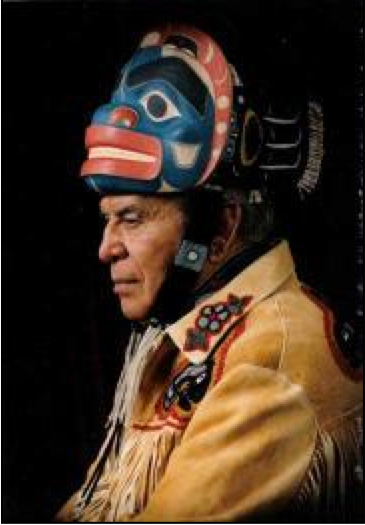
When Nainoa arrived at Fisherman's Wharf the air was thick with cigarette smoke and lunchtime conversation. Herb introduced him to Judson Brown.
"Judson was a large man," Nainoa remembers. "He had a deep strong voice and a kind smile. He was quiet but welcoming. His eyes had seen a lot. I didn't know anything about him. I Only knew that among his people he was a respected elder."
Judson Brown was born in 1905 in Klukwan, a tiny village 40 miles up the Chilkat river from Haines, Alaska - the seaport terminus for a huge wilderness north of Juneau. Among his people, the eagle moiety of the killer whale clan of the Tlingit nation, Judson is known as Gushklane, which translates roughly as "Big Fin." During Judson's childhood, the early 1900s, there was little opportunity for formal schooling, until Congress finally passed an act to establish schools for the education of Native Alaskans. Judson was one of the first from his village to be sent away to such a school. There, he learned to read and write in English, to recite the pledge of allegiance and such other skills that Congress, in its wisdom, thought would help him make his way in the white man's world.
"Judson's history is fascinating," Nainoa explains. "He began working when he was a teenager for the betterment of his people. The abuse that went on in Alaska was like the abuse that went on over here. They rounded up children from different tribes and sent them away to school. The schools were like prisons. The children were taken from their families and that destroyed many families."
"Native Alaskans were not allowed to vote," Nainoa continues, "until congress was finally forced to give them the right. But there was a catch, to register you had to recite the pledge of allegiance in English and be able to sign your name. When they had the first election, no one in Kluckwan voted because no one could speak English. Judson was still in high school then but he knew how to speak and write English, so he went at night with a lantern to every household in the village and he taught the people how to mimic the pledge of allegiance and to make their signature. Within one year, someone from his tribe won the mayor's race. Judson was a teenager when he did that."
When Judson graduated from high school he joined with other native activists to sue the United States for claims to their land which eventually resulted in a settlement that returned millions of acres to Alaskan native peoples. The government considered the land to be virtually worthless - a distant wilderness with few roads to extract the resources of timber and fisheries that existed there. But in the early seventies, oil was discovered in Prudhoe Bay on the North Slope. The best way to get the oil to the continental United States was a pipeline across the land. The wilderness had all of a sudden become extremely valuable.
"Judson was a member of the group that filed the first land claims suit," Nainoa recalls. "He was that kind of guy - very visionary."
During lunch, Herb and Nainoa explained the Hawai'iloa project to Judson. If they could not find koa trees in their forest, would Judson help them?
"He was very quiet and patient. He listened. After we explained the whole project he simply quietly said: 'we will give you the trees so you can build the canoe to carry your culture.' He understood fully what we were trying to do. It was about reviving our culture. He knew the trees would be the tools."
"The relationship between my people and all that is in the forest and the sea is one of interdependence," Judson told Nainoa. "The resources from the sea and forest have allowed our people to survive over all these centuries. Because of that relationship we treat everything in the forest and the sea as family. Giving you two trees is like giving you our children. So we will not cut the trees until you let us know exactly what you need and we will go into the woods and find the trees and then you must come and inspect them before we cut them."
"Judson's wisdom came from his kupuna," Nainoa explains. "It is their guiding values. It's the kind of wisdom we always seek in the older generation. What he told me was extremely powerful. I was in charge of building a canoe and that was my narrow focus, but around it were all these layers of values that I did not clearly see. I understood them, I felt them, but I did not articulate them clearly. I was too busy thinking of deadlines and logistics. Judson brought in a new set of values. Judson also clearly saw a bridge being constructed between his people and ours. He saw it from the very beginning."
"After talking with Judson, I knew we had a second source of trees," Nainoa continues, "but I didn't want to make that choice. I wanted to find the trees in our own forests because it would demonstrate that our ecosystem was still healthy. So we spent a year searching for the trees all over Hawaii. When we didn't find them I was depressed. I felt guilty. But I didn't completely understand these feelings. There were ten trillion other things that had to be done to keep the canoe project going. I didn't have the time to think out what was truly troubling me."
About a year after meeting Judson and a few days after coming out of the Kilauea forest, Nainoa called Judson Brown. The conversation was cordial but short. "We need the trees," said Nainoa. "Come to Alaska, they will be ready for you," was the reply.
3. A Flight to Alaska
On the flight to Alaska, Nainoa looked down on vast tracts of uninhabited land. He was stunned by the country's unspoiled beauty, unlike anything he had seen before in his life. His plane landed at the airport which was on a small island separated from the town of Ketchikan by a rapidly flowing channel. The water appeared cold and gray - uninviting, even dangerous. He took a small ferry across the river to Ketchikan, a fishing village that had expanded over the years to a small town of perhaps 10,000 people and a cannery.
"That night I met Ernie Hillman, the chief forester for the Sealaska Corporation," Nainoa recalls. "He was a quiet man - a native Alaskan - fair and tall, with a long face and strong features. He was in good shape. He looked like he had been outdoors a lot. He had white hair and I guessed he was in his sixties. When you look at him you know he knows his work. I remember I was in small hotel room and he came in and sat down and in a strong voice he introduced himself. There was a real sense of security about Ernie. I felt like I could depend on him."
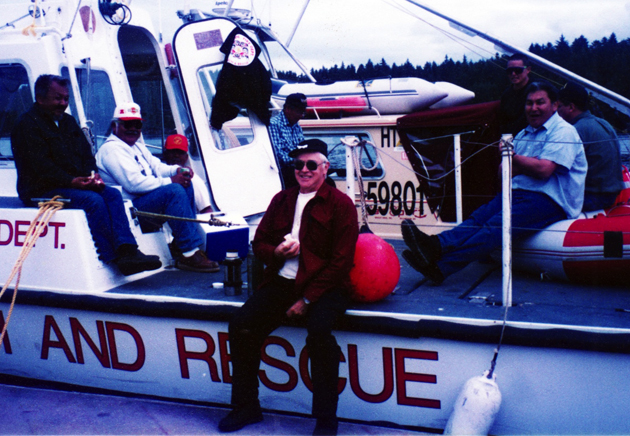
Ernie hanging with an Alaskan search and rescue crew, 1995
"He said, 'You have to come to inspect the trees. We're ready for you.'"
The next day, Nainoa and Ernie boarded a DeHaviland Twin Otter on floats. The plane climbed out over the town of Ketchekan and set a course west over the fjord-like Tongass narrows, over Gravina island crenellated with peaks still bearing a skim of snow and out over Clarence Strait which shimmered in the early morning light. Nainoa sat up front, behind the pilots. Ernie Hillman sat next to him. Although he was a native Alaskan, Hillman's Caucasian genes were predominant. He was lanky and deeply tanned. His movements were purposeful and precise. His glance was friendly - if somewhat guarded.
"I think he was genuinely puzzled about why he was sitting next to a guy from Hawaii on a trip to look at two large trees," Nainoa remembers.
The plane droned on over vast stretches of untrammeled wilderness. Though Nainoa and Ernie sat shoulder to shoulder in the small aircraft, an intimacy enforced by the cramped cockpit, they said nothing. Their silence was based on the men's' complementary natures.
"We are similar I think, because we are both shy people,' Nainoa explains. "I take time to build relationships. I like to listen before I say anything. And I think Ernie is the same way. It wasn't that I felt uncomfortable with Ernie. Just the opposite. He is a proud man. Self confident. He gets things done, but he doesn't say a lot."
Circling over Soda Bay, the aircraft descended toward Schelikoff Island. They passed over an Alaskan brown bear swimming in the channel between the island and the mainland. Craning his neck, Nainoa watched the bear's progress until he lost sight of it behind the Twin Otter's rear stabilizer. The bay was sullied by white caps. The pilot throttled back, the plane skimmed the water and settled deeply into it. The propellers thumped languidly. There was a slight bump as the floats touched land.
The men drove in a Sealaska truck along a narrow logging road cut through tall stands of timber. To Nainoa, the trees seemed huge beyond imagining.
"I was starting to get this instinctual sense of how powerful Alaska is. There was something so very different about it, something alluring, just one of those places. It was very spiritual, and that makes me quiet and humble. The place is so wild and so clean and still so natural. I was beginning to face up to the reckless changes taking place in Hawaii, especially on Oahu, and not being able to do anything about it. When I was a kid I felt very lucky to be born in Hawaii - and I still do - but the reefs in Maunalua bay were still alive then, now they are dead."
"In Alaska I got a sense of youth - everything is so young and clean and healthy," Nainoa continues. "I thought about the difference between Alaska and Hawaii - the size, the resources, and how people treated the resources. I thought about why I felt so attracted to this place. I love Alaska. It's a place of rejuvenation for me."
For six weeks, Ernie Hillman had searched the immense forest for two unusually large spruce trees. Hillman's job as forest manager was to balance the cutting of trees - and the impact their loss might have on the environment - with the financial return. So enamored was he of his forest that some of his colleagues called him a "conservationist." The word was not a complement among most Alaskans, and it missed its mark. Ernie knew the forest had to be cut, he understood well the basic economics of his profession. But before each cutting, he aimed to be certain the need balanced the loss. Now, accompanying this young Hawaiian to a spot he had discovered a week earlier, he was puzzled. What were the trees for? Why did they have to be so large?
After descending a slight hill, the truck jolted to a stop. The men got out and walked about three hundred yards with Ernie leading the way through what appeared to Nainoa an arboreal maze. Presently, Hillman halted before two trees that towered over the others.
"We came to a place about a mile from the floatplane." Nainoa says. "I could see the water all around us. Ernie had the specifications in his hand, the size of the trees we needed. We wanted them to be seventy-two feet long, eight feet in diameter at the base, and six feet at the top. The trees he had selected were 220 feet tall. I had never seen trees like that before, giant evergreens. They were breathtaking. Ernie was very proud of being able to complete his task. He was very task oriented. Give him a job and he will do it, and do it well - in his own way and at his own pace."
"He said: 'Shall we cut them?'"
"I saw the trees and I didn't say anything," Nainoa continues. "I didn't want to cut the trees down. Something was wrong. There were just too many of them. They were too beautiful. They were too full of life. I started to weigh the value of our project and the value of the life of the trees. When Ernie asked if we should cut the trees down, I didn't answer him. Virtually, I told him "no" but I didn't give him an answer. I was just too troubled. It was a tough time for me. Ernie got real quiet."
"I was very conflicted. The trees were so magnificent and beautiful. I was not ready to be responsible to cut down those trees. It was my choice. If I said yes, they would have cut them down. We got in the airplane and flew back. We didn't talk. There was nothing to talk about."
4. Byron Mallott, CEO of SeAlaska Corporation
On the same day that he came out of the forest, troubled by complex feelings and unable to give the order to cut the trees, Nainoa flew to Juneau to meet with Byron Mallott, the CEO of Sealaska Corporation and a colleague of Judson Brown.
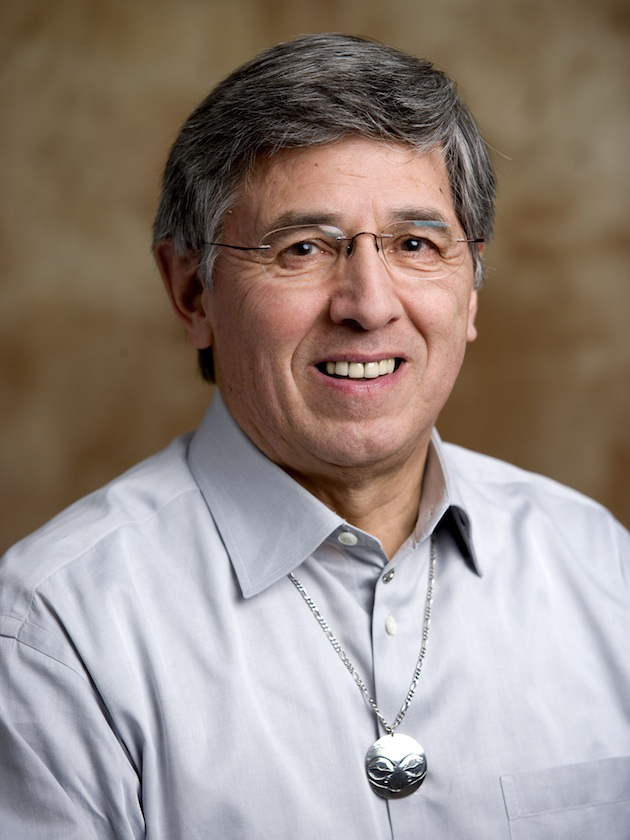
"I flew to Juneau," Nainoa recalls. "I stayed in an old hotel on the slopes of a mountain overlooking the city. The room was dimly lit, and I called home that night. I was troubled. I don't remember what I said. The next morning, I had an early lunch with Byron."
"Byron was a quiet man," Nainoa continues. "He was dressed in a plaid long sleeve shirt, jeans, and hiking boots. He appeared to be intense - a lot of things were on his mind. He understood what our project was about - otherwise he would not have supported it. He knew there was a risk. He was responsible to his shareholders. Byron told me he was born in a village called Yakutat, another cannery town. His mom was pure native Alaskan and his dad was a non-native from the West Coast of the U.S. Later I learned that he was on just about every single board there was to be on. He was head of The Nature Conservancy. He was made CEO of Sealaska at age 34 - all these huge accomplishments. But he had not even finished college because had to take care of his dad when he got sick."
Ironically, Nainoa and Byron had both appeared in separate National Geographic Magazine articles in 1976 - though they were not aware of it at the time. Nainoa was featured as a young sailor aboard Hokule'a and Byron as an Alaskan firebrand looking out for the rights of his people.
"I learned that there is a very powerful drive in Byron that you would not normally see because he is so quiet. It is inside of him. As a child he saw the pain of what happened to his people, the abuse of his people, the alcoholism, the spouse and child abuse that went on in families in the villages. And he really wanted to make a change, so he stood up and took a stand. He was very young, in his late twenties, but he was very vocal about his beliefs."
"Byron told me about one of the most important turning points in his life," Nainoa continues. "It happened at a meeting when the governor of Alaska stepped forward and said, 'OK, Mr. Mallott, you have all these accusations about how bad we are treating your community. But how do you know?'"
"Byron said, 'What do you mean - how do I know?'"
"'There are many separate communities all through Alaska, have you been to all of them?'" the governor asked him.
"Byron said, 'No.'"
"'Well then,' the governor told him, 'you ought to go see them.'"
"So the Governor sponsored Byron as part of his staff to visit every single community in Alaska for two years," Nainoa explains. "That was an enormous turning point. He was sent to all these communities to observe and learn. Alaska is huge, very diverse - there are Eskimos and Athapaskans and Aleuts, Tlingits, and Haidas - many tribes. That two years of traveling really opened Byron's eyes."
"When we first met," Nainoa continues, "I wasn't prepared to share what I was thinking and feeling because I wasn't sure what it was. Here's the man that's giving us the trees. I had never met him before. And he's quiet, too. I am the kind of person that, if I don't know you, I'm not going to say anything unless you ask me. That's my nature. I didn't know Byron. Byron didn't know me. Maybe he was expecting me to ask him about the trees and since I didn't there wasn't much to talk about. That's my guess. We had a very quiet lunch. He asked me what I felt about Alaska and that's all that I remember about the conversation. We didn't even talk specifically about the trees."
A few days later, still troubled by his confused reaction to cutting down the trees, Nainoa flew back to Hawaii.
5. Advice from a Kupuna
Shortly after Nainoa returned from Alaska, the board of directors of the Native Hawaiian Culture and Arts Program, the official sponsors of the Hawai'iloa project, met at the Bishop Museum.
"I gave my report and the board was puzzled by it," Nainoa remembers. "Here I had accomplished my mission. We had the trees just for the asking, all our problems were solved. Accepting the trees followed historical precedent, Vancouver had reported a canoe made of pine, and it was an opportunity to join with another native group that wanted to share with us. I understood all that. I understood that what we had set out to do we did very well. We obtained the trees that we knew would keep the project going, but I just wasn't OK with it."
Among the board members attending the meeting at the Bishop Museum was John Dominis Holt. Holt was a kama‘aina - a member of an old family with deep ties to the islands.

"John knew that I was troubled about cutting the trees," says Nainoa. "It wasn't so much what I said but what I didn't say and how I acted - no excitement. It was not my nature. I didn't say, 'Hey, we accomplished our mission. It's all set up.' None of that. I just gave a quiet uncommitted report back to the board. After that, John came up to me and said, 'why don't you come to my house for lunch?'"
A few days after the board meeting, Nainoa drove up a long driveway in the Pacific Heights neighborhood - an enclave of expensive old homes overlooking Honolulu. The driveway was lined with groves of mock orange and tall Banyan trees gnarled with age and it arced through manicured lawns that would have done credit to a golf course.
"The house was old style," Nainoa remembers, "with big windows all around and views through them of Honolulu. There were a lot of paintings and there were maids and gardeners."
John Dominis Holt was a tall man, a little heavy set, fair, with white hair. He had a deserved reputation as an elegant public speaker who wove wit and humor into his presentations. He took pride in dressing well.
"He stood very erect and when he spoke he gazed upward at the ceiling," Nainoa recalls. "He talked to you very personally, but he always looked away."
"John was an interesting man," Nainoa continues, " a writer and a publisher. He had a great passion and love for Hawaii and its people. He really cared, but he came from a very affluent life so in some ways his contributions, I think, were made in a kind of isolation from the community - not that the community didn't like him - but the community didn't really know how to relate to him. That's my sense. He was a wonderful, kind, kind man. He had a passionate regard for Hawaii and its people. John Dominis Holt was of a different era. He was the end of that era."
John Holt expressed his affection for Hawaii as a writer and publisher of books on Hawaiian subjects including, in 1964, a volume entitled "On Being Hawaiian" and a reminiscence of early childhood summers in Waimea, on the Big Island.
"We sat down to lunch - very prim and proper. It was very different than I would normally have lunch, you have to worry a little about how to behave. We made small talk and then John turned to me all of a sudden and he asked me, 'Nainoa, tell me your dreams.'"
Nainoa was surprised by the question but he realized that it came from a deep place in John Holt's understanding of Hawaiian culture. "It came from John Holt's aloha for everything around him," Nainoa explains. "He was trying to find out what was the real reason I couldn't cut the trees down. Because I couldn't answer rationally, John was trying to get to a deeper level. Asking about the dream was his avenue to the unconscious."
"I think every single one of us who is Hawaiian, finds an instinct way deep within us - the Na‘au - not the intellectual, but the more spiritual part of who we are. We are still very connected to the earth because of who we were," Nainoa continues, "and we have been disconnected because of this overwhelming change that came with the new order, the new Western world, with depopulation. And it has put to sleep that powerful connection to mother earth. It's instinctual, not intellectual - what is right by our instincts and our soul - which is very much a part of Hawaiian decision making."
Nainoa paused for a moment to think before answering the question. He had, in fact, experienced a recurring dream. It was a replay of the search for koa with Tava in the Kilauea Forest. In the dream, as the men come out of the forest, Nainoa feels a heavy pain in his shoulder, a pain so severe that it always caused him to wake up, startled and confused. Taking his time, Nainoa carefully told Mr. Holt the details.
Now it was time for John Dominis Holt to pause and carefully consider what he had heard. He looked up at the ceiling, then focused his gaze carefully upon Nainoa, looking deeply into his eyes.
"He told me that to understand the dream I had to realize that it was all about the pain that I felt on leaving the forest," Nainoa remembers. "John was very precise in his words. He was a very articulate speaker. He said, 'You know Nainoa, everything that you need to do is in front of you. It is very close to you. But you are just not able to see it. Not only are the problems there, but also the solutions.' He said to me, 'I know that you know the answer.'"
6. Understanding the Dream
After speaking with John Dominis Holt, Nainoa returned home to his Grandmother's house in Niu Valley, pondering what he had been told as he drove along the Kalanianaole highway. The answer was in the pain, Mr. Holt had explained, and it was very close - so close that Nainoa could not see it. What did that mean? Parking his car in the driveway, Nainoa walked up into the pasture behind his grandmother's house to think.
"In those days my dad was on the Board of Trustees of the Bishop Estate," Nainoa recalls. "Back in 1977 there was a movement by The Nature Conservancy in Hawaii to get the Federal Government to condemn the Kilauea Forest and to give it to them for conservation. My dad was angry about that because it was an effort to take land away from the estate, but he also recognized there was a need for a response. He studied the problem and discovered that the forest was in bad shape. So he started a reforestation program. I think the first tree planting started in 1977."
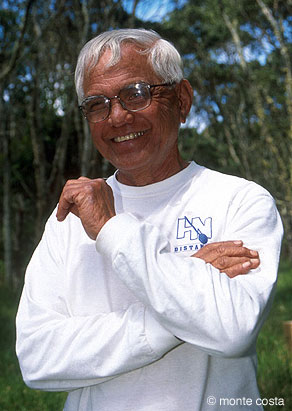
Nainoa's father - the forest - the pain - the replanting program; could these be clues to the meaning of the dream?
"I think that's what John meant when he said the answer was close,' Nainoa explains, "it was in my family history. When Tava and I were searching the forest, we passed the area that had been replanted with koa. I didn't think of that when we walked through the forest, but all the answers were there. All the pieces of the puzzle were right in front of me - I just never saw it."
"We were not just searching for koa trees in the forest," Nainoa continues, "we were searching for a sense of hope. When you step inside the koa forest it feels quiet and sacred - but it has been very abused. I think in searching the koa forest we created a spiritual relationship to that place and way down deep inside that connection was painful. But the solution to the pain was not clear. When Tava and I walked out of the Kilauea Reserve I was too focussed on managing a voyaging canoe project. It wasn't until the confrontation with Ernie that I recognized that here was something more import then that. If that were the highest priority then we would have cut down the trees."
At the time, Nainoa's family - his grandmother Clorinda Lucas, his parents Pinky and Laura, his brother Myron, his sister Lita and her husband Bruce Blankenfeld - lived in three houses on a common plot of land at the head of a deep valley in Niu, under the shadow of Kulepemoa Ridge. Driving into the family compound, a visitor encountered first the canoe house of the Hui Nalu Canoe Club where a half dozen or so racing canoes were stored and where you almost always found club members laboring over a canoe, or meeting, or just hanging around in quiet comradeship. It's a scene out of a more ancient way of life in Hawaii. Perhaps with a minor stretch of the imagination you could say it was a mini-ahupua'a - a place containing almost all that was needed, a supportive family and an extended ohana of friends and relatives. During a week or so of thinking about his dream and its meaning, Nainoa consulted informally with his ohana. Gradually, the answer to the problem of cutting down the trees in Alaska emerged.
"Even though we did not directly cause the abuse of our forest," Nainoa recalls, "we needed to take responsibility for it if we cared for the land. Our culture flourishes from that caring. So gradually the answer became clear, we needed to plant tees in our own forest before we cut any down in Alaska."
7. Healing Our Souls
A few months later, just about where Nainoa had felt the pain in his dream - at the fence line separating the Kilauea Forest Reserve and the Keahou Ranch - a circle of about a hundred people joined hands for a prayer. They had spent most of the day replanting koa trees, now it was time to ask the akua to bless their work.
"When it became clear that we needed a step in between going to Alaska and cutting the tress down I felt a deep sense of relief and freedom," Nainoa recalls. "We knew what we had to do to restore the balance - to be pono. We held the ceremony on the edge of the forest, on the fence line, just outside the reserve on the slope of Kailua."
The circle of men and women joining in the prayer and the renewal of the forest was in some ways a microcosm of a new way of life that was emerging then in Hawaii - a way of life that combined keiki and kupuna, activists who worked on the front lines for the renewal of Hawaiian culture and those who worked quietly behind the scenes, cowboys and sailors, men and women of all races - an ohana of people created out of a common vision. Randy Fong was there from Kamehameha School to help conduct the ceremony. Kalana Silva, who was instrumental in Hawaiian language immersion, was there; also Robert Kekealani from Puuwaawaa, a well known kupuna of the ranch and forest; and Ricky Tavares, who had been the ranch manager for Keauhou Ranch and who helped guide Nainoa through the reserve to look for the trees. Also in the circle were many members of Hokule'a's crew - Tava Taupu, Shorty Bertelmann, Clay Bertelmann, Chad Baybayan and others. Nainoa's parents were there along with Agnes Cope and other board members of the Native Culture and Arts program. And there also to join hands was John Dominis Holt.
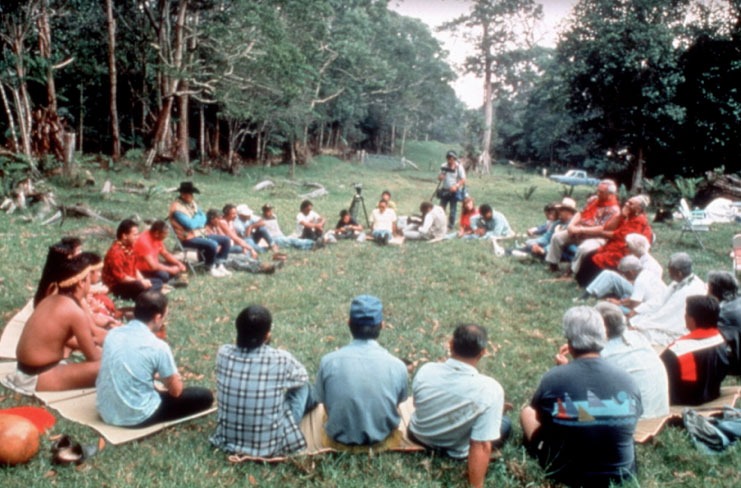
"John knew that I had to search for the answer at a level that was much deeper than the intellectual," Nainoa explains. "I could not cut the trees down because it felt wrong for the environment, but it was deeper than that. When we put our thoughts about the environment over here and we put our feeling of na'au over there and we have no link between them, we feel disconnected. Our sense of balance is destroyed. Walking out of the forest with Tava was painful because we had destroyed that very sacred place, our koa forest, and that hurt at a very deep level. It was much more than an environmental issue. We hoped the replanting would send a message about replacing abuse with renewal. It was symbolic of making choices that we all felt very good about. All of us. It laid the groundwork for a new emphasis within the Polynesian Voyaging Society - a new program that we call Malama Hawaii - an opportunity for caring and making the right kind of changes in our island environment."
"Among that group at the replanting were members of the board of directors from Sealaska - including Byron and Judson. It was a diverse group, a sense of growing community. What started as a project of artisans and people within the Hawaiian voyaging culture now extended out as far away as Alaska."
Byron Mallot spoke during the ceremony - presenting his vision of the healing of abuse and the renewal of a native culture in both Alaska and Hawaii. And near the end of the ceremony, Judson Brown rose to speak. As he walked to the center of the circle the silence was profound. Nainoa remembers hearing only the soft flow of wind up the mountain.
"I will never forget his words," Nainoa explains. "He said, 'have no fear when you take your voyage because we will always be with you. When the north wind blows take a moment and realize that the wind is our people joining you on your voyage.' Judson was the spiritual link between his people and ours. He was clear about the canoe we would build and about the voyages we would make. It wasn't about navigation. It wasn't about building a canoe. It wasn't about the stars. It was about bringing people together. He always saw Hawai'iloa as a celebration of native culture."
The sun was beginning to set by the time the ceremonies were finished. As the men and women of the ohana made their way to their cars, the slanting light picked out the leaves of the new koa seedlings in the dappled shade of the forest. For a moment, Nainoa remembers, they seemed infinitely delicate in the fading light. "But then I remembered the image of children and grandchildren putting their hands in the earth," he says, "and I saw what the seedlings meant. As we were healing the earth we were also healing our souls."
8. Soul of the Forest
On the day that Nainoa and the delegation from Hawaii traveled to Shelikof Island in Alaska to receive the gift of spruce trees, the forest was dense with life. There were flights of raven and Canada geese, solitary rufous hummingbirds and bald eagles, Sitka black tailed deer, moose and brown bear. But for all this, it was the trees themselves that astonished the Hawaiians - colonnades of trees that shadowed the landscape all around so that little grew beneath the tall canopy, producing a feeling that the land had been swept clean by some unknowable and fastidious spirit.
"There were representatives from Sealaska and the Native Hawaiian Culture and Arts Program," Nainoa recalls. "Wright Bowman, our master builder who would make Hawai'iloa from the trees was there. A Kupuna named Keli'i Tau'a conducted the Hawaiian chants alongside Paul Marks who came to chant for the Tlingit people and Sylvester Peele who chanted for the Haida people. My mother and father were there. Judson and Byron were there. When we walked down to the trees from where we parked the trucks everyone was talking, it was so beautiful and invigorating, but when we got there and looked up at the trees it became very quiet."
"We thanked the spirit of the forest for the gift of the trees," Nainoa continues. "First we thanked them in Hawaiian and then we thanked them in the Tlingit language. We were two very different cultures, from two very different lands, but it seemed to me that we gave thanks in a way that was very similar. We were two people separated by a great distance and by history, but we thought about the spirit of the land in a way that was very similar."
When the ceremony was finished, Ernie Hillman and his crew moved forward. Nainoa remembers the sound of chain saws reverberated through the forest, a sound that seemed for a time to sever a still place deep inside him. He appreciated the expertise of the foresters - how they knew exactly where to make a wedge-shaped cut to aim the trees' descent and how they left a hinge of wood at a precise point in the cut to slow the rate of fall. Yet for many of the Hawaiians who watched, it also felt as if they saws were cutting into living flesh. They had never seen such trees before, and they had certainly never participated in the death of such a massive life form.
"I couldn't watch," Nainoa remembers. "Out of respect for the gift and for Ernie and his men, we had to stay while the trees were cut. But when the final moment came, I had to look down at the ground. I only looked up when the first tree had finally fallen but I will never forget the sound it made. It was like a scream of agony from the very soul of the forest."
Shortly after Nainoa returned from Alaska he received an envelope postmarked Juneau. Inside was a letter from Byron Mallot, a response to a question Nainoa, deeply shaken by the cutting of the trees, had asked him on the way back to Ketchekan - "do you think personally that we should have the trees?"
"Both the reality and the symbolism of the (Hawai'iloa) project," Byron wrote, "brings hope and inspiration to all peoples seeking to maintain their traditions, heritage and culture. In a society that does not place a high priority on such things - except when they may touch a nerve - you help nurture shared values through an expression of such vision, initiative and sheer innate beauty and strength that all can feel ennobled by it. The voyaging project is that kind of expression. You do it for the Hawaiian people but it reaches far beyond. In your canoe you carry all of us who share your vision and aspirations for a people to live and prosper with their future firmly built on a knowledge of their heritage and traditions."
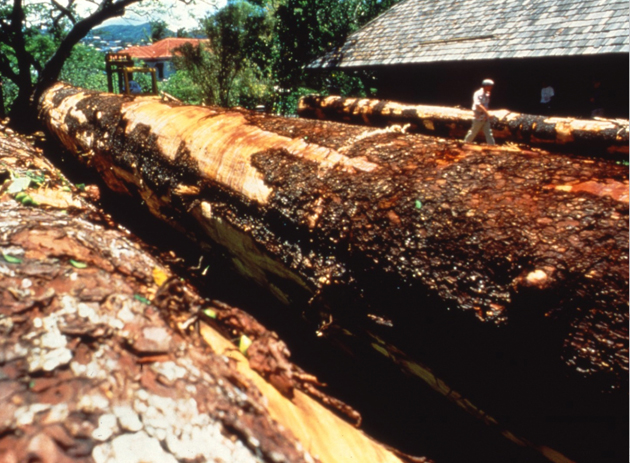
Spruce Logs delivered to the Bishop Museum
On July 24, 1993, Hawai'iloa was finally launched. A few weeks later, sea trials began. Byron Mallot flew in from Juneau to stay with Nainoa for a week and to take a voyage aboard the canoe.
"Byron came to Hawaii for one of the original sea trials of Hawai'iloa," Nainoa remembers, "and when he walked on board the crew members didn't really know who he was. They knew he gave us the trees, but they didn't know the man. He is a very quiet and private man and when he came aboard he didn't say much. It was not like him to give a speech."
"When we were sailing, I saw him climb into one of the hulls. He was fiddling around there but I didn't pay much attention to it. Then suddenly he called out my name - pretty loudly. I thought that something must have happened, so I ran over and I looked down at him and there were tears flowing down his face. He looked up at me and he said, 'Hawaii Loa is alive. These trees are alive.'"
9. True Wealth
In February of 1995, a large group of people gathered at the Nani Loa hotel in downtown Hilo for the departure of Hawai'iloa on her first maiden long distance voyage. The canoe would sail with Hokule'a to Tahiti where she would join with two canoes from the Cook Islands, two from Tahiti and one from Aotearoa (New Zealand) to begin a return trip back to Hawaii via the Marquesas. It was the first time in a thousand years that a fleet of Polynesian canoes had sailed together over an ancient voyaging route. There were many chants. There was classic Polynesian hula. Pinky Thompson, President of the Polynesian Voyaging Society, spoke to thank the Alaskan people for their gift of the two giant spruce trees that now lived again as Hawai'iloa's twin hulls. Finally, Judson Brown rose to speak.
"He got up in front of a large crowd of people," Nainoa recalls, "and he said: 'I am very grateful that the Hawaiian people would thank us for what the Alaskan people have done. But in truth, all we did was give you trees from our forest. What you gave was far more important - you gave us dreams.'"
"Everyone was absolutely silent. Think about what he said. He clearly understood that we were building a bridge between native people. His role was critical - not just in getting the trees - but in the celebration of our culture. Even though Hawaiians and Alaskans were different people - defined by their environment, language and culture - in the end Hawai’iloa was embraced by Native Alaskans as their own. Judson was so proud. He truly loved Hawaii."
On May 15, 1995, having completed her voyage to Tahiti and back through the Marquesas, Hawai’iloa was shipped aboard a freighter. Landing in Seattle, she began a voyage of thanksgiving up the coast and inland waterways of Alaska. Byron Mallot was often aboard and Ernie Hillman, captaining his fishing boat, escorted the canoe through Alaskan waters during her entire visit.
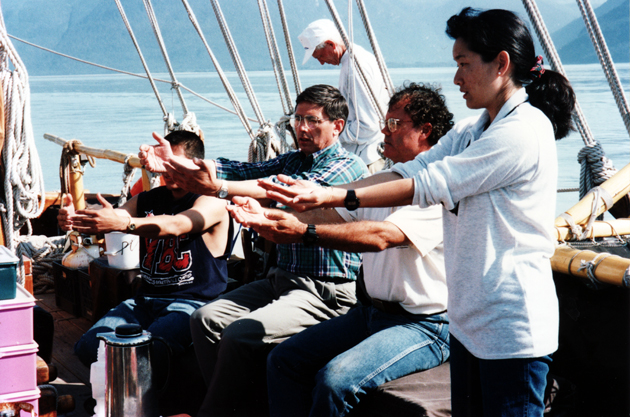
Byron Mallot (middle) learning hula from Brad Cooper on Hawai‘iloa on the way to Haines, Alaska. 1995
In Haines, Alaska, Hawai'iloa's crew were greeted in a uniquely Alaskan ceremony - a potlatch.
"We went to Haines and we were taken into a small building by a river, a simple and humble place with a wooden floor," Nainoa remembers. "We sat on the floor and the people gave us a potlatch. They heaped gifts before us. I was embarrassed. I saw an elderly lady sitting against the wall in the back of the room. There was a young boy with her, her grandson I supposed. Toward the end of the gift giving I saw her hand to him a small package. She seemed kind of embarrassed about the gift, almost ashamed. The young boy walked quietly up to the front of the room and put the package on the pile of gifts. It was composed of hundred dollar bills. I was shocked."
"I turned to Judson Brown and said, 'I don't know how to respond to this kindness.'
‘Our idea of wealth,’ he told me, ‘is not about accumulating but giving away. We have survived as a people for centuries by caring for our natural environment and by sharing with each other.’"
On May 14, 1997, Judson Brown passed away. He is buried in his native village of Kluckwon where, over sixty years ago, by the light of a flickering kerosene lantern, he first began teaching his people about their rights. Judson had lived a life expressive of his Tlingit name, Gushklane - Big Fin - the one who has guided his people with wisdom and with a deep belief in the values of not only his ancestors, but the traditional values of all people.
"Judson Brown is still with us because the bridge between the people of Hawaii and the people of Alaska that he built is still strong," Nainoa says. "After Judson's death, his people carved two totem poles. They brought one to Hawaii with fifty people to celebrate the union between our people in the Bishop Museum's Hall of Discovery. At the ceremony there was another elder, Alan Williams, who said: 'we are doing this as our contribution to keeping alive the bond between Hawaiians and Native Alaskans.'"
"They set up the other totem pole in Juneau, Alaska," Nainoa continues, "and that is the anchor for the bridge that Judson envisioned - one that will always connect our two people and our common values of preserving and sharing the wealth of our natural environment and our cultures."

Hawai‘iloa in the Northwest Forest, on her way to visit Alaska, 1995.
Related articles: The Building of Hawai‘iloa and Hawai‘iloa’s Northwest-Alaska Journey, May-July 1995.
